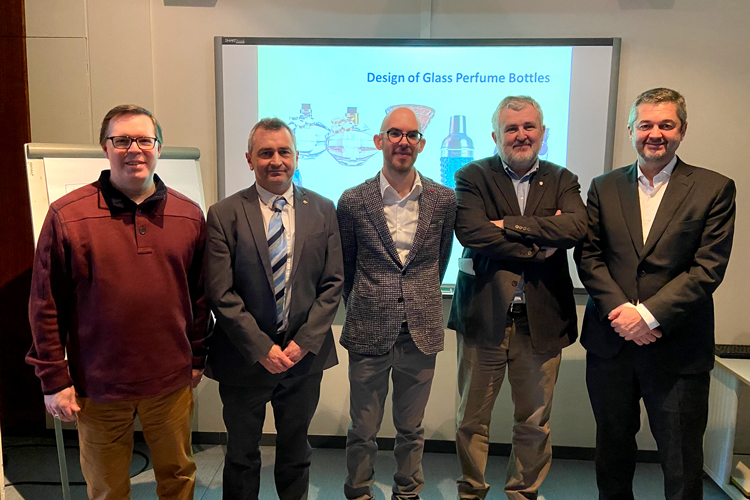Within the collaboration agreement between the company Ramón Clemente and IQS, Dr. Adrià Biosca defended his doctoral thesis on the numerical and experimental study of prediction of the distribution of glass in the manufacturing process of all types of bottles, to achieve optimization of these industrial processes.

Dr Matthew R. Hyre, Dr Andrés Garcia, Dr Adrià Biosca, Dr Salvador Borrós and Dr Vicenç Pedret
Designing the mould is a critical point in manufacturing glass containers, especially in the development of new bottles , as this defines how the thickness of the glass is distributed throughout the bottle. However, these cavities are designed based on empirical knowledge and traditional trial and error methodology. As such, it may be necessary to conduct various manufacturing tests that involve non-productive times and delay development time until achieving the desired product.
Ramon Clemente, a company that has manufactured perfume bottles for 85 years, wanted to add a simulation tool to predict how glass would be distributed in its bottles during the production process. This initiative led to the Vidresim project, conducted in collaboration with the Industrial Product Engineering (GEPI) and the Materials Engineering (GEMAT) research groups at the IQS School of Engineering, as part of the ERDF research support programme. The company is thus meeting its goal of implementing a numerical description of the thermo-mechanical behaviour of glass that bridges the current divide between the experience of glass-makers and the scientific knowledge of numerical simulations.
Within this collaboration agreement, Dr Adrià Biosca defended his doctoral thesis on the numerical and experimental analysis of glass in the double blown manufacturing process, to predict the distribution of the glass thickness in the later bottle production stage. The thesis has been co-directed by IQS professors Dr Andrés Garcia, of the GEPI research group, and Dr Salvador Borrós, of the GEMAT group. Dr Biosca's research has also relied on support from Dr Matthew R. Hyre, an associate professor at Northwestern University (Illinois), an expert on computational models, simulations and mathematical models.
Numerical models developed in IQS
Dr Biosca started his thesis by conducting thermal and finishing analyses of the glass under real manufacturing conditions. With the operations to form the glass and the properties of the glass itself, Dr Biosca defined the theoretical framework to model the double blown process, with the simulation program ANSYS Polyflow.
Later, two numerical models were implemented. The first model, using a simplified case, studied how a drop of molten glass falls onto a grey smelting plate, which obtained the glass flow over time and validated the viscosity of the glass by Ramón Clemente, as well as the non-isothermal and expected Newtonian flow for the simulations.
Once the numerical approach and the experimental methodology were validated through a simplified case, a much more ambitious numerical model was then developed which defined the glass flow at high temperatures in the double blown process. This second model helped to define the thermo-mechanical behaviour of the glass during the expansion stages in the moulds under industrial conditions and was able to predict the distribution of the thickness of the glass in the manufactured containers.
The results allow for a better understanding of the thermo-mechanical behaviour of the glass in the mould cavities. Additionally, the simulations managed to correctly predict the distribution of the glass thickness at the end of the process, based on the design of the mould cavities and the conditions of the manufacturing process, both in the axisymmetric as well as in the three-dimensional model , with robust results coherent with the bottles produced.
The vision of Ramón Clemente
For the company, validating the three-dimensional model helped open the door to numerically predicting all kinds of glass bottles, both those with complex geometries as well as asymmetric bottles. This model also reduces pilot tests and expensive manufacturing tests prior to launching new products.
“With this project, we have aimed to go one step further and turn empirical and traditional knowledge of glass bottle design into more scientific and technical knowledge. We wanted to work together with IQS due to its extensive knowledge and willingness to be open to new technology transfer projects”, said Dr Vicenç Pedret, CEO of Ramón Clemente.
This research has received funding from the European Regional Development Fund (ERDF), for the NUCLIS 2016 research and development support programme.











